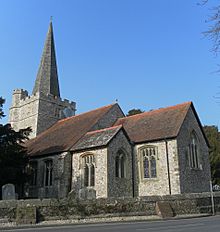St John the Baptist's Church, Westbourne facts for kids
Quick facts for kids St John the Baptist's Church |
|
|---|---|
 |
|
| 50°51′37″N 0°55′40″W / 50.8604°N 0.9278°W | |
| Location | The Grove, Westbourne, West Sussex PO10 8UL |
| Country | England |
| Denomination | Anglican |
| Website | http://westbourneparishchurch.org.uk |
| History | |
| Status | Parish church |
| Founded | Early 13th Century |
| Dedication | John the Baptist |
| Architecture | |
| Functional status | Active |
| Heritage designation | Grade I listed |
| Style | Perpendicular Gothic |
| Administration | |
| Deanery | Westbourne |
| Archdeaconry | Chichester |
| Diocese | Chichester |
| Province | Canterbury |
The Church of St John the Baptist is an old church in the village of Westbourne, West Sussex, England. It's an Anglican church, which means it's part of the Church of England. The church is named after John the Baptist and belongs to the Diocese of Chichester.
Contents
History of St John the Baptist's Church
The Domesday Book, a famous survey from 1086, mentions two churches in the area. It's possible one of these was in Westbourne. The church we see today has parts that date back to the early 1200s.
How the Church Grew Over Time
In the early 1200s, the church had a main area called a nave and side sections called aisles. It also had a chancel, which is the part of the church where the altar is.
Later, in the late 1300s, big changes were made. The nave and aisles were made longer. New windows were put in, and a tower was likely built in the south-west corner. After these changes, the church became the size it is today.
In the early 1500s, the church was updated again. The main area (nave) was changed to the Gothic perpendicular style. This meant thick pillars were replaced with tall, thin ones. The chancel was made taller and wider, and a porch was added on the north side. A new west tower was also built around this time.
Important Dates and Changes
- 1545: A beautiful avenue of Yew Trees was planted. People believe it's the oldest in the United Kingdom.
- 1598: Galleries were added over the aisles, and dormer windows were put in. A flat ceiling was added to the nave.
- 1770: A spire was added to the tower, making it even taller.
- 1797: The church floor was redone with Purbeck stone and brick. New pews (church benches) were installed.
- 1860s: Some parts of the spire and tower were removed. In 1865, a big restoration happened. Old boxed pews and galleries were taken out. New pine pews were put in, and a south porch was built. An expert named Nikolaus Pevsner didn't like these changes much.
- 1876: An organ room was built, and new seating for the choir was added.
- 1957: The spire was repaired, and a weather vane that had been blown off in 1894 was put back.
- 1978-1981: The vestry (a room for clergy) was made bigger, and the church floor was redone in stone.
All the stained glass windows you see today were put in between 1865 and 1912. The church graveyard stopped accepting new burials in 1859.
In 1892, a tin church was built in the nearby village of Woodmancote. It became part of the Westbourne church's group.
Worship and Music
St John the Baptist Church holds services every Sunday. These include Parish Communion and early morning communion. There are also services at the Woodmancote church or evening services at the main church. On Wednesdays, there's a morning Holy Communion service.
The church uses both the Book of Common Prayer and Common Worship for its services. It tries to offer services that welcome people of all ages. Activities include Sunday school for kids and a junior choir. Music is very important here, with a strong choir that provides choral music.
The Church Organ
The first mention of an organ in the church was in 1819. In 1862, a new organ was installed by J. W. Walker & Sons Ltd. It was made bigger in 1876. More additions were made in 1890. In 1967, the organ was rebuilt by Hele & Co, changing how it worked. In 2001, Kenneth Tickell & Co built the new organ that is still used today.
- Learn more about the organ on the church website
- Details of the Kenneth Tickell organ from the National Pipe Register
Church Bells
The church originally had four bells in 1724. This number grew to six in 1770 and then to eight in 1933. Today, the church uses full-circle ringing, and the bells are rung for Sunday services. The heaviest bell, called a tenor bell, weighs almost half a ton.
See also
- Grade I listed buildings in West Sussex
- List of current places of worship in Chichester (district)

